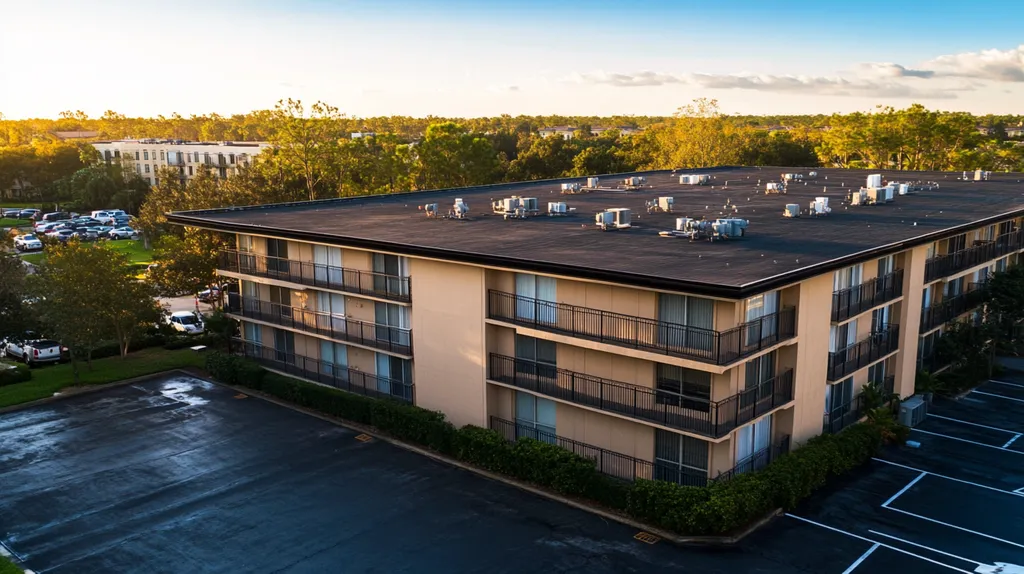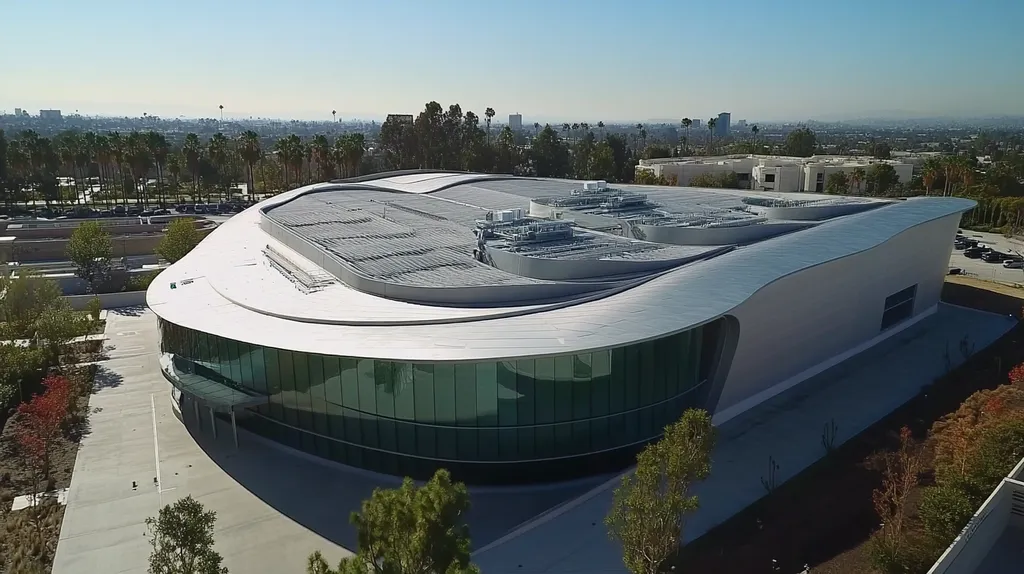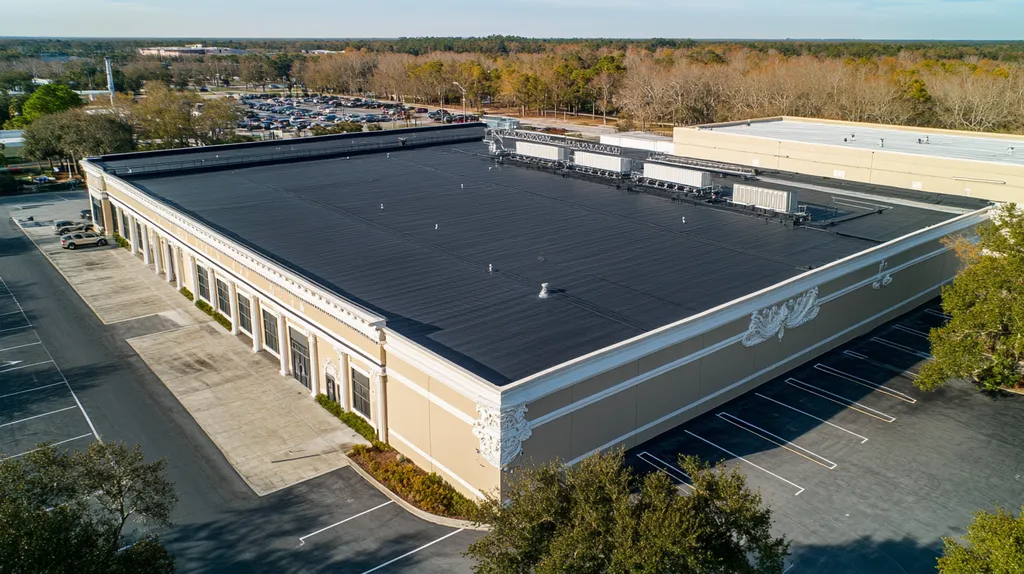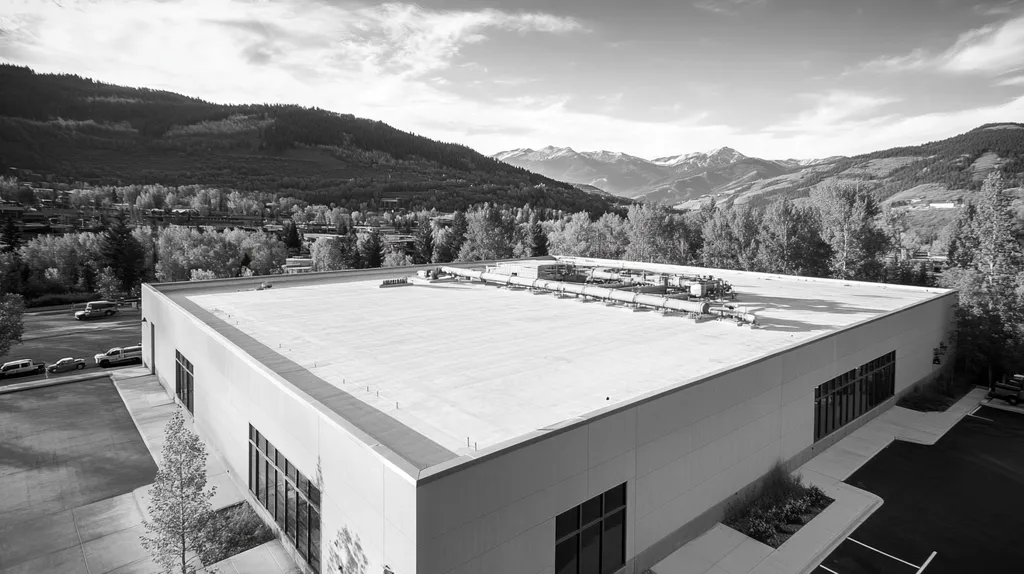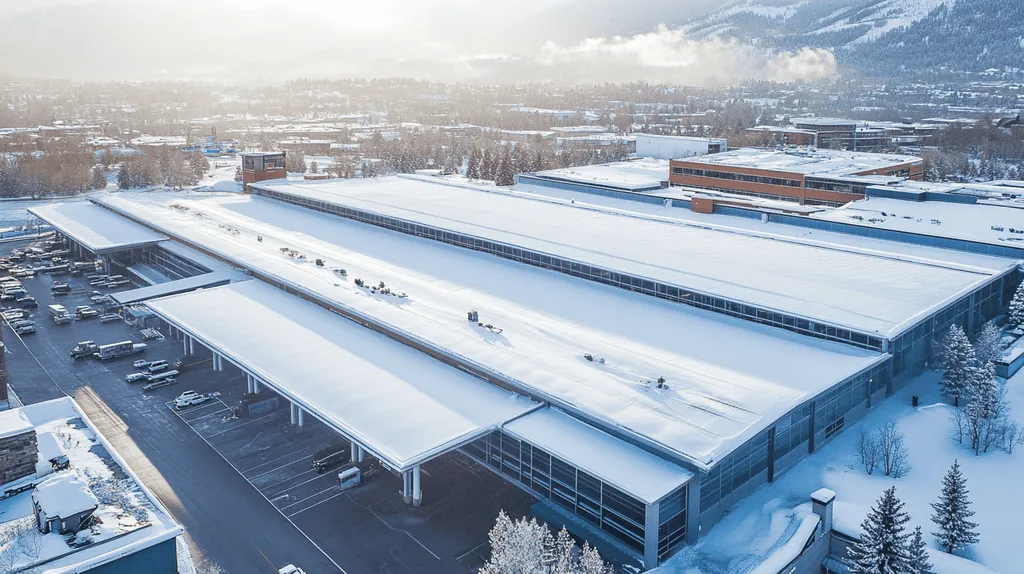As energy costs continue to surge and extreme weather events intensify, commercial property owners face mounting pressure to extend roof lifespans while reducing operational expenses. Studies show that energy-efficient roofing materials can cut cooling costs by up to 40% while doubling a roof’s functional lifespan.
Yet many property managers struggle to navigate the complex landscape of modern roofing solutions, often overlooking critical factors that impact long-term performance and sustainability. This comprehensive guide examines the essential elements of roofing material selection, from durability metrics to financial considerations.
By understanding these key components, property professionals can make informed decisions that transform their highest square footage into an asset, combining protection with energy efficiency and sustainability.
SECTION 1: PERFORMANCE FACTORS
As rising energy costs and extreme weather become more commonplace, the focus on the durability and efficiency of commercial roofs is crucial for property owners. Buildings that utilize energy-efficient roofing materials can cut cooling costs by as much as 40%. Property managers need to prioritize material durability, energy efficiency, and weather resistance to enhance roof lifespan and safeguard their investments effectively.
Material Durability and Resistance
The type of roofing material chosen can drastically impact a roof’s performance and longevity. Premium options like TPO (Thermoplastic Olefin) and EPDM (Ethylene Propylene Diene Monomer) provide outstanding durability. These materials can withstand the damaging effects of severe weather, UV radiation, and moisture infiltration, which are often responsible for roof failures.
For example, TPO membranes are renowned for their ability to resist tears and punctures, making them a perfect fit for busy commercial roofs. Additionally, many roofs constructed with these materials come with warranties that extend up to 30 years, offering long-term protection for property investments.
By using durable materials, property managers can not only improve their roofs’ longevity but also lower maintenance costs significantly. Opting for materials with a proven history of performance can prevent frequent repairs that can disrupt business functions and deplete budgets.
Key Action Items
Energy Efficiency and Reflectivity
Choosing energy-efficient roofing materials is essential for decreasing overall energy consumption in buildings. Reflective roofs, known as “cool roofs,” help reduce heat absorption, which directly lowers air conditioning needs. This strategic choice can lead to significant energy savings over time.
For instance, white or light-colored membranes exhibit high reflectivity, reducing the urban heat island effect often seen in crowded cities. By embracing such materials, commercial structures can enjoy cooler internal temperatures while significantly cutting energy expenses.
Additionally, energy-efficient roofs can qualify for various financial incentives or rebates, further motivating property owners to make these upgrades. A roof that effectively reflects heat not only boosts sustainability but also increases the property’s overall value.
Key Action Items
Weather Condition Tolerance
The capacity of roofing materials to endure various weather conditions is vital for achieving long-term performance. Commercial roofs must face heat, heavy rainfall, strong winds, and hail. Selecting materials engineered to handle these challenges can significantly prolong a roof’s lifespan.
For example, modified bitumen and standing seam metal roofs are known for their exceptional durability against severe weather, which helps to minimize risks of leaks and structural damage. These materials are designed to flex with temperature changes, preventing cracks and splits.
Moreover, roofs engineered to withstand high wind speeds can resist uplift forces, which contribute to roof failure. With the help of anchors and reinforcements, these materials help ensure roofs remain secure even in harsh conditions.
Key Action Items
SECTION 2: FINANCIAL CONSIDERATIONS
Managing the financial aspects of a commercial roof is crucial for maintaining property value and ensuring sustainability. Given the increasing expenses associated with energy consumption and repairs, selecting the right roofing materials is vital. Although energy-efficient options may require a higher upfront investment, they deliver essential long-term savings that can dramatically improve profitability and operational efficiency for property managers.
Initial Installation Costs
Investing in energy-efficient roofing materials often involves a greater initial cost compared to traditional alternatives. For instance, advanced materials like TPO or reflective membranes may require a higher upfront investment due to their advanced properties. Nevertheless, the choice of roofing has far-reaching impacts on energy consumption and overall operating expenses.
The advanced installation techniques required for energy-efficient systems can further affect these initial costs. Employing skilled labor and using high-quality materials are critical to maximizing roof performance and longevity. Understanding these costs allows property managers to make informed financial decisions that favor long-term sustainability.
Importantly, viewing this investment as a long-term strategy can yield dividends. Over time, property owners often recoup their initial investments through savings on energy bills and reduced maintenance costs, thereby reinforcing overall building performance.
Key Action Items
Long-Term Maintenance Savings
Energy-efficient roofing materials typically demand less maintenance compared to their traditional counterparts. Their increased durability translates into fewer repairs and less frequent replacements, offering substantial savings for facilities managers. A well-maintained energy-efficient roof can last significantly longer, often 20-30 years, which markedly outpaces less efficient options.
Additionally, these materials help minimize heating and cooling costs, leading to even lower long-term expenses. Buildings equipped with reflective roofing can maintain cooler indoor temperatures, reducing reliance on air conditioning and energy consumption.
As a result, regular maintenance becomes less frequent due to the enhanced resilience of these materials. This not only conserves financial resources but also allows facilities managers to allocate time and budget to other critical areas of maintenance, ensuring better overall management of the property.
Key Action Items
ROI on Energy-Efficient Materials
The return on investment (ROI) associated with energy-efficient roofing should not be underestimated. Though the initial costs can deter some property owners, the long-term benefits often overshadow these concerns. Energy savings, prolonged roof life, and reduced maintenance collectively contribute to a favorable ROI.
Research indicates that properties with energy-efficient roofs can expect an ROI of 10-15% or more throughout their operational lifespan. This can equate to substantial financial gains, especially for larger commercial spaces that consume significant energy resources.
Moreover, energy-efficient roofs can enhance property values, attracting tenants who prioritize sustainability. Financing options and incentives are often available to ease the burden of initial costs, making these investments increasingly accessible and beneficial.
Key Action Items
SECTION 3: COMPLIANCE REQUIREMENTS
Neglecting compliance requirements in roofing projects can result in serious legal and financial repercussions. For example, failing to meet building codes could not only result in fines but also jeopardize the safety of building occupants. As energy-efficient materials continue to evolve, understanding the compliance landscape is crucial. This section highlights the key compliance areas that property professionals must navigate to ensure safety, sustainability, and longevity.
Building Code Adherence
Building codes set essential safety and performance standards for roofing systems, ensuring they can withstand various environmental stressors like heavy rain and strong winds. For instance, the International Building Code (IBC) outlines specific guidelines related to materials and installation practices.
Property owners should familiarize themselves with local codes, especially those that pertain to energy-efficient materials. Complying with these regulations not only enhances safety but also bolsters roof lifespan by improving structural integrity.
Violations can lead to costly delays and extensive remedial measures. To navigate these challenges, property professionals should partner with experienced roofing contractors well-versed in local regulations.
Key Action Items
Environmental Regulations
Environmental regulations increasingly impact roofing projects, particularly in relation to material selection. The Environmental Protection Agency (EPA) enforces rules that limit harmful substances in roofing materials, ensuring roofs do not contribute to pollution or hazardous waste.
Choosing energy-efficient materials not only facilitates compliance with these regulations but also aligns with sustainability objectives. Many municipalities provide incentives for utilizing eco-friendly products, reducing initial costs while promoting responsible construction practices.
Ignoring environmental regulations could lead to financial penalties and damage to a property’s reputation. Conducting a thorough assessment of relevant guidelines for roofing materials and installation methods is essential for compliance.
Key Action Items
Industry Standards and Certifications
Familiarizing oneself with industry standards and certifications is essential for ensuring the quality and performance of roofing systems. Organizations like the American Society for Testing and Materials (ASTM) and the Cool Roof Rating Council (CRRC) develop benchmarks that promote the use of high-performance materials.
Utilizing materials that meet or exceed these standards not only enhances energy efficiency but also contributes to a roof’s longevity. For example, roofs certified by Energy Star often deliver significant energy savings.
Opting for certified materials can also elevate property values by ensuring roofing systems are built to last. Property professionals should prioritize manufacturers and contractors offering products with recognized certifications.
Key Action Items
SECTION 4: RISK MANAGEMENT
Proper risk management is essential for maintaining the integrity of commercial roofs. Failure to address vulnerabilities can lead to structural damage, costly repairs, and safety hazards. With water damage being a primary cause of property loss, proactive measures are necessary to protect investments. This section outlines key areas that property managers should prioritize to mitigate risks and ensure long-lasting roof performance.
Identifying Potential Failure Points
Proactively identifying potential failure points in roofing systems is vital for property owners. Common issues such as inadequate drainage and poorly installed materials can create vulnerabilities. Areas where roof edges meet walls or where seams are located are especially prone to leaks.
Regular inspections are crucial to catching these problems early. Utilizing infrared technology can help detect hidden moisture and avert major damage. Additionally, engaging professionals for periodic evaluations reinforces roofing integrity.
Understanding the lifespan of various roofing materials is also significant. Some materials may experience quicker degradation in harsh environmental conditions. By planning for timely replacements, property managers can effectively reduce risks.
Key Action Items
Mitigating Water and Moisture Damage
Moisture intrusion represents one of the most significant risks to commercial roofing systems. Establishing a solid waterproofing strategy is essential for preventing leaks and water-related damage. This includes using high-quality membranes and ensuring proper sealing at vulnerable seams and penetrations.
Routine maintenance is vital in managing moisture effectively. Regularly clearing debris from gutters and drains helps prevent water pooling, reducing potential damage. A planned maintenance schedule can significantly minimize water-related issues.
Incorporating energy-efficient materials that reflect sunlight can also enhance moisture control. These materials are often more resilient against harsh weather conditions, offering both energy savings and improved protection against moisture.
Key Action Items
Preventing Structural Integrity Issues
Maintaining structural integrity is critical for the safety and longevity of commercial roofs. Factors such as heavy snow loads, severe temperatures, and inadequate support can compromise roof strength. Regular evaluations help ensure roofs can withstand these pressures.
Thermal expansion poses another risk to structural integrity. Different materials expand and contract with temperature swings, potentially stressing seams and joints. Opting for materials engineered for thermal stability can help mitigate this concern.
Investing in additional supports, like trusses, can enhance a roof’s stability. Consultation with professionals about the roof’s load-bearing capacity is essential, especially during periods of extreme weather.
Key Action Items
SECTION 5: OPERATIONAL PROCEDURES
Implementing effective operational procedures is essential to prolonging the lifespan of energy-efficient commercial roofs. Without regular inspection and maintenance, roofs face costly repairs and risk premature failure. Research indicates that ongoing maintenance can extend a roof’s life by over 30%, significantly reducing replacement costs in the future. This section highlights the necessary procedures to keep roofs performing optimally for years.
Regular Inspection and Maintenance
Regular inspections are key to spotting potential issues before they evolve into major problems. Property managers should plan to conduct inspections at least twice a year, ideally during spring and fall. This proactive approach allows for early detection of issues such as cracks, blisters, and standing water.
During these checks, professionals can assess the condition of energy-efficient materials, ensuring they function as intended. For example, reflective membranes may need cleaning to retain their energy-saving qualities. Maintenance also involves clearing gutters and drains to prevent water buildup.
Documenting inspection results and maintenance activities is crucial. This record helps track the roof’s condition and serves as valuable information for future repairs or replacements. Hiring certified roofing professionals for thorough inspections ensures adherence to industry standards, protecting the property investment.
Key Action Items
Addressing Common Issues and Repairs
Quickly addressing common roofing issues is crucial for extending the lifespan of commercial roofs. Membrane damage from severe weather or excessive foot traffic is a frequent problem. Immediate repair of any tears or punctures is essential to prevent leaks from forming.
Seam failure is another significant concern due to thermal expansion and contraction. Regularly resealing seams helps prevent water infiltration, safeguarding the underlying structure. Make sure repairs use compatible products to maintain the performance of energy-efficient materials.
Property owners should also watch for signs of moisture damage inside the building, such as stains or mold, which often indicate roofing issues needing prompt attention. Taking a proactive stance in addressing these challenges curtails extensive damage and mitigates costly repairs in the long term.
Key Action Items
Training Facility Maintenance Personnel
Training facility maintenance personnel is vital for effective roof management. Staff must understand the unique characteristics and care requirements of energy-efficient materials. Training sessions should emphasize best practices for conducting inspections and maintenance tasks.
Equipping maintenance teams with this knowledge empowers them to tackle minor issues efficiently before they escalate. For example, training on cleaning reflective surfaces can enhance their energy-saving capabilities—an essential element for operational cost management.
Incorporating safety training is equally important, ensuring that staff can work safely on roofs, thus minimizing injury risk and damage to the property. Investing in training fosters a knowledgeable team capable of maintaining the roof’s condition and maximizing energy efficiency throughout its lifespan.
Key Action Items
SECTION 5: OPERATIONAL PROCEDURES
Implementing effective operational procedures is critical for maximizing the lifespan of energy-efficient commercial roofs. Without regular inspection and maintenance, roofs can suffer from costly repairs and premature failure. Studies show that proactive maintenance can extend a roof’s life by over 30%, ultimately lowering replacement costs. This section outlines essential procedures that ensure roofs remain efficient and operational for years to come.
Regular Inspection and Maintenance
Routine inspections are essential for catching potential issues before they escalate. Property managers should schedule inspections at least twice a year, ideally during spring and fall, to identify problems such as cracks, blisters, and standing water early on.
These inspections provide an opportunity for professionals to assess the condition of energy-efficient materials and ensure they are functioning as intended. For instance, reflective membranes might need to be cleaned regularly to maintain their energy-saving capabilities. Additionally, clearing debris from gutters and drains is crucial to preventing water accumulation.
Documenting inspection results and maintenance activities is vital. This record not only tracks the roof’s condition but also serves as an invaluable reference for future repairs or replacements. Engaging licensed roofing professionals ensures thorough inspections are conducted according to industry standards, protecting property investments.
Key Action Items
Addressing Common Issues and Repairs
Timely intervention for common roofing issues can significantly enhance the lifespan of commercial roofs. Membrane damage—often caused by severe weather or foot traffic—is a frequent issue. Repairing any tears or punctures immediately is essential to avoid leaks.
Seam failure can also occur due to thermal expansion and contraction. Regularly resealing seams can prevent water intrusion, protecting the roof structure. Ensure that repairs utilize compatible products to maintain the performance of energy-efficient materials.
Property owners should be vigilant for signs of moisture damage inside the building, such as stains or mold, which may indicate roofing problems needing urgent attention. Adopting a proactive approach to addressing these challenges can minimize extensive damage and costly repairs in the long term.
Key Action Items
Training Facility Maintenance Personnel
Investing in training for facility maintenance personnel is essential for effective roof management. Staff should understand the unique characteristics and care requirements of energy-efficient materials. Training sessions focused on best practices for inspections and maintenance processes enhance overall roof performance.
This knowledge empowers maintenance teams to identify and address minor issues swiftly before they escalate. For example, training on how to clean and maintain reflective surfaces can significantly enhance their energy-saving capabilities, which is crucial for managing operational costs.
Incorporating safety training is equally important, ensuring personnel can perform their tasks safely. Knowing how to work on rooftops minimizes the risk of injury and property damage, fostering a competent team that effectively maintains the roof’s condition.
Key Action Items
Looking Ahead
With energy costs projected to rise 30% over the next decade and extreme weather events increasing in frequency, the selection of energy-efficient roofing materials has never been more critical for commercial properties.
Studies demonstrate that implementing the strategies outlined in this guide can extend roof lifespans by 50-100% while reducing cooling costs by up to 40%.
Property managers who prioritize material durability, compliance requirements, and systematic maintenance protocols position themselves to maximize their roofing investments.
The future of commercial roofing lies in the integration of energy-efficient materials with proactive operational procedures.
Those who act now to upgrade their roofing systems will gain significant competitive advantages in operational costs, building value, and environmental impact for decades to come.
FREQUENTLY ASKED QUESTIONS
Q. How does material durability affect my commercial roof?
A. The durability of roofing materials impacts longevity and maintenance costs. Durable options like TPO and EPDM resist weather damage, reducing the risk of failures. By selecting quality materials, property managers can significantly enhance the lifespan of their roofs and minimize repair expenses.
Q. What are the long-term financial benefits of energy-efficient roofs?
A. While energy-efficient materials may have higher initial costs, they offer substantial long-term savings. Reduced energy bills and lower maintenance needs lead to a favorable return on investment. Over time, property owners can recover initial expenditures through these savings, boosting overall profitability.
Q. Why is compliance important for commercial roofing projects?
A. Compliance with building and environmental regulations ensures safety and avoids costly penalties. Meeting these standards enhances the roof’s structural integrity, balancing performance with legal responsibilities. Property managers should work with knowledgeable contractors to navigate compliance effectively and protect their investments.
Q. What are the key risks associated with commercial roofs?
A. Common risks include water intrusion, material wear, and structural integrity issues. Addressing vulnerabilities proactively through regular inspections and maintenance is essential. By identifying and mitigating these risks, property managers can maintain roof performance and extend its lifespan effectively.
Q. How often should I inspect my commercial roof?
A. It is recommended to inspect commercial roofs at least twice a year, ideally in spring and fall. Regular inspections can help identify potential issues early on, allowing for timely repairs that can significantly prolong the roof’s lifespan and effectiveness.
Q. What training do maintenance personnel need for roof care?
A. Maintenance personnel should be trained in the unique care requirements of energy-efficient materials. This includes best practices for inspections, preventive maintenance, and safety protocols. Proper training enables staff to efficiently address minor issues before they escalate, safeguarding the roof’s condition and performance.
Q. How can I improve moisture management on my roof?
A. To enhance moisture management, implement a robust waterproofing strategy with high-quality membranes. Regularly inspect seams and drainage systems to prevent water accumulation. Routine maintenance, including cleaning gutters and removing debris, can further minimize risks associated with moisture damage.

